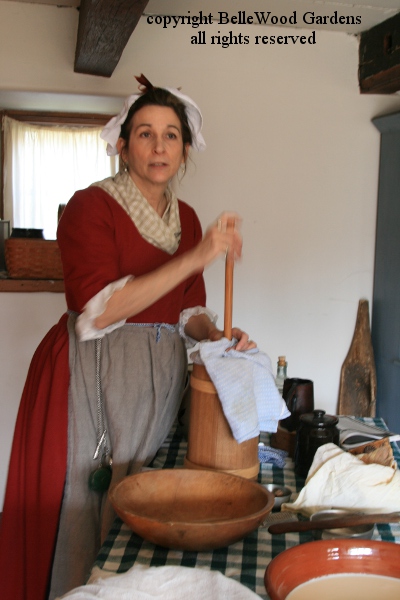
.
If you have any comments, observations, or questions about what you read here, remember you can always Contact Me
All content included on this site such as text, graphics and images is protected by U.S and international copyright law.
The compilation of all content on this site is the exclusive property of the site copyright holder.
Come, butter, come,
Come, butter, come!
Peter stands at the gate,
Waiting for a buttered cake;
Come, butter, come.
The earliest reference I could find for this Mother Goose nursery rhyme is from Thomas Ady in his 'Candle in the Dark' which was published in London in 1656, He wrote that this was a charm to make butter come from the churn, and was to be said thrice.
Where does the butter come from? Why, from milk! Raw milk fresh from the cow contains butterfat as a mixture of large and small particles held in suspension. Because they are lighter, just like oil and water, if whole milk is left standing the lighter material - cream - rises to the top of the container.
The earliest method for cream separation involved pouring milk into shallow setting pans which were placed in a cool room for a day or two. This allowed the cream to rise to the top, then be skimmed off.

A beautiful redware setting bowl, at Bouman Stickney Museum on Sunday, 6 March 2016

It was a gift to Connie Unangst, today's presenter, from a potter.
Before homogenization cream would naturally rise to the top of the milk bottle. If you wanted to pour off the cream some milk would just mix with it as the cream was poured out.

Then a milk bottle was designed that had a bulge at the top of the bottle's neck. The opening at the bottom of this swelling was smaller than the opening at the top of the bottle. When the cream rose up in the bulge a special spoon or separator could be used to close off the neck between the cream and the milk so the cream could be poured out and the milk would remain in the bottle.

By the mid-1800s inventors first applied centrifugal force
to the separation of milk into skimmed milk and cream.
This was a game changing invention. Commercial dairy farms expanded, taking the place of small rural family farms with just a few cows where some of the skimmed milk was consumed by the farmer and his family, while the rest was used to feed calves and pigs. Excess cream was sold, with enough cream saved to make butter.
To turn butterfat into butter can be done by simply shaking cream in a jar with a well fitting lid. Fill the jar halfway with cold cream. Screw on lid. Shake, shake, shake. First it will slosh into whipped cream but you must keep going until it seperates into butter and buttermilk.

By early 20th century, a jar fitted with paddles and a crank simplifies things.

Cream in the glass jar butter churn and start cranking away.

An old style ceramic butter churn. It amuses me that the glaze looks like spilled cream.

A larger, wooden butter churn. These work by pulling / pushing the dasher up and down.

Connie holds a cloth around the dasher to keep cream from splashing out the lid's opening.

It's butter! But Connie is not done, She smooths it with a cherrywood spurtle

then pours some cold water over it to begin washing traces of buttermilk away.

She paddles it, pours off the now watery buttermilk, rinses and paddles several times.

The buttermilk makes a fine beverage and may be used in baking too. Feed it to your pigs and chickens (should you have any.) It is different from today's store-bought buttermilk which is cultured from milk, rather than what remains after making butter.

A butter mold, for an elegant finished product.

Starting with two pints of organic cream Connie guesstimates that she's made about 3/4 to a pound of butter. Everyone is eager for a sample. I spread a little on a cracker. Oh my! Is this good. It has a silky mouthfeel , melts away with no greasy aftertaste. Delicious!
My thanks to the Bouman Stickney Museum for a wonderful 18th century butter- and cheese-making event. To Howell Living History Farm for their recent Winter Kitchen event. And to Holcombe Jimison Farm for their lovely dairy display of antique bottles, a glass butter churn, and more at the Hunterdon County Headquarters Library, in New Jersey.
Back to Top
Back to March 2016
Back to the main Diary Page